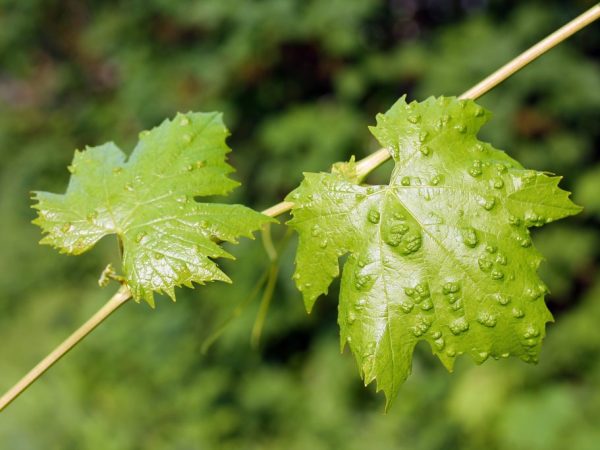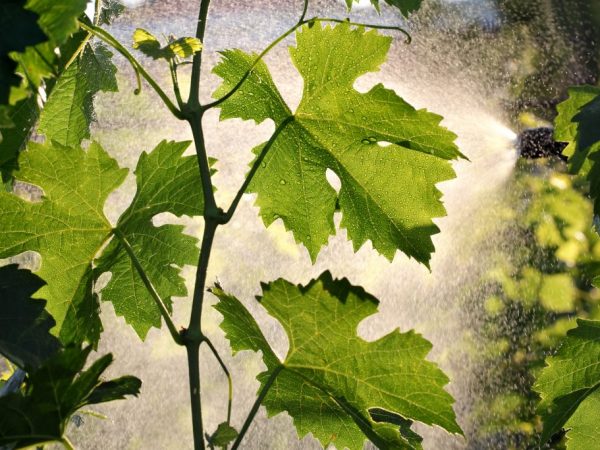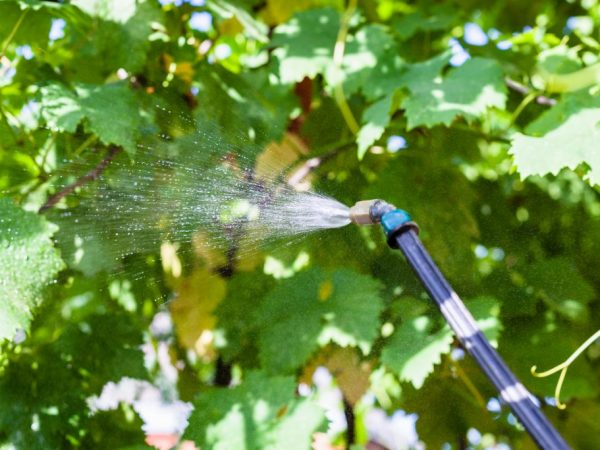Fighting a tick on grapes
More than 75 species of mites infect grapes. Among the common types are red greenhouse, leaf, herbal, garden. The grape mite is eliminated by a complex of chemical and folk methods.

Fighting a tick on grapes
Pest characteristic
The pest belongs to gall mites. Its body length is up to 0.14 mm, which makes it invisible to humans. The body is elongated, transparent, with two long antennae in the posterior part.
The body has 5 or 6 pairs of short antennae. There are 4 legs with the help of which the spider parasite moves.
Both females and males breed. They produce 8-9 generations every year. Development from egg to adult occurs within 10-12 days. The grape mite hibernates between the scales of the buds. Crawls out in early spring at temperatures from 15 ° C.
Signs of defeat
In search of symptoms of damage, they examine the parts of the plant that are eaten by the spider mite on the grapes:
- leaves;
- kidneys;
- unripe or ripe fruits.
The grape mite marks are immediately visible on the leaves of the grapes. On the obverse, small, shaped bumps of a brownish-brown or green color appear.
On the inside, cotton-like white growths are visible, similar to felt. As the colony grows, they turn brown, connect with each other.
In case of severe damage, the grape mite moves from the leafy part to the bunches. Unripe berries dry out and take on an ugly shape. Ripe fruits darken to brown. Felt plaque appears. In rainy weather, grapes rot, covering neighboring clusters.
Grape mite harm
Grape itch feeds on the sap of the plant. He sucks it out of the leaves by piercing them. Then he injects poisonous salivary fluid. It causes a reaction in which leaf tissues change shape, die off. The leaves dry up, curl,
The parasite leads to impairment of photosynthesis in the green part of the plant. The transfer of essential substances is difficult.
Lesions with grape itch and mites significantly reduce the yield. In severe cases, up to 80%.
Chemical fight
Chemical methods of combating mites on grapes are used for moderate and severe lesions. Sulfur-containing agents are effective against the pest. Preparations for ticks on grapes are used at an air temperature of 20 ° C.

Processing is carried out in calm weather.
To work with them, a number of rules are followed:
- protection of hands, feet, face, body with special clothing, footwear;
- a ban on smoking, drinking any food fluids;
- strict adherence to drug dosages;
- breeding in non-food non-metallic containers.
Processing is carried out during the growing season, no later than 30 days before harvest. The funds are sprayed early in the morning or late in the evening. The weather should be calm, humidity should be medium or slightly high.
Actellic
Means "Actellik" refers to insect-acaricides. Treatment takes place with the active ingredient pirimifos-methyl.The preparation is suitable for use against insects and grape mites. It has a contact-intestinal non-systemic effect, does not harm the plant. It is toxic to bees and humans in increased doses.
Getting into the body of the parasite, Actellik disrupts the work of its enzymes that conduct neuromuscular impulses. The agent accumulates in the body, disrupts all processes. He is poisoned by poisons.
Among the advantages of the drug is the fumigation effect. It is used to control pests that have settled on the inside of the leaf.
The drug is used in a dosage of 2 ml. The concentrate is stirred in 0.7 l of water. This is enough for 5 m². The bushes are sprayed 2 times with a break for a week.
The substance acts quickly. It begins to influence pests after 10-120 minutes, depending on the stage of development of the grape mite and the climatic conditions of the region. After treatment, the preparation protects the plant for up to 2 weeks.
If the dosage is observed, the grape leaf mite does not get used to the product. It can be combined with other substances.
Omite
To combat grape itch use a broad-spectrum insecticide "Omite". It affects the grape mite with 30% propargite. Destroys all types of parasites by contact, during evaporation.
Subject to the recommendations on the packaging of the product, it is not toxic to:
- beneficial insects;
- predatory grape mites;
- person.
The drug quickly penetrates the wax coating of the leaves, it is not washed off by rain. It is resistant to direct sunlight and works under continuous light.
The product is diluted in the amount of 10-20 ml / 5 l of water. The solution is treated up to 10-12 m². The mixture is active for 2-3 days. The protective function lasts up to 30 days.
The liquid should not be stored for more than 1.5 hours. It is recommended to spray immediately after dilution. The substance is incompatible with oil-based preparations and products with a high alkaline balance.
Fufanon

Preparations will help get rid of the tick
The drug from the grape mite "Fufanon" refers to insecticides with a wide range of effects. It destroys parasites by contact-intestinal and fumigation methods using the active substance malathion (570 g / kg). It is sold as a clear concentrated emulsion.
The working solution against the grape mite is prepared by mixing 5 mg of the substance with 1.5-2 liters of water at room temperature. Add water to obtain 5 liters.
The vineyard is sprayed with freshly prepared liquid, using 3-4 liters of solution per 1 bush. The procedure is repeated after 10 days.
During processing, make sure that the liquid does not run down the leaves. The drug begins to affect parasites in 30-60 minutes. The protective effect is extended up to 4-5 days after spraying.
Fight with folk remedies
With the initial damage to some leaves of the vineyard, mechanical measures to combat grape itch help get rid of the pest. Affected leaves are cut, destroyed. If after that the grape mite reappeared, folk remedies and methods are used: an infusion of onion husks, a decoction of dry black shaves (marigolds).
200 g of husk or marigolds are poured into 1 liter of water. The mixture is insisted for 2 days in a cool dark place. The infusion is filtered, crushed laundry soap is added. Then mix thoroughly, bring to 1 liter with warm water. The vineyard is sprayed with a fine-hole spray bottle. Abundantly work out the lower part of the sheet. The procedure is carried out once a day for a week.
To combat the grape mite, crushed green potato tops are used. Take 1-1.2 kg, diluted with 2 liters of boiling water. Leave in a dry, dark place under the lid until morning. The next day, filter through cheesecloth, add warm water to 10 liters. Leaves and bunches are sprayed on both sides once a day. The processing period is 5-6 days.
Folk remedies with garlic help to save young seedlings from felt mites on grapes.One of the effective recipes: 50 g of cloves are crushed, diluted with 500 ml of boiling water, insisted for 15-20 minutes.
Next, the working solution is diluted with 1 liter of water. The seedling is sprayed from top to bottom for 7 days. A new solution is prepared every day. Covering the seedling with a polyethylene bag helps to get rid of the parasite for a long time in order to kill individuals at all stages of development.
Prevention
Prevents infestation of grapes by following preventive measures to combat itch on grapes. They suggest:
- timely destruction (burning) of foliage from last year;
- digging up land near the vineyard in the autumn-spring season;
- removal of the lower leaves of the bush;
- timely tying of grapes;
- regular watering of the plant according to an individual calendar.
The risk of parasite infestation is reduced by planting the crop in a dry place. Free air circulation between leaves and bunches minimizes the possibility of pest development.
Conclusion
Felt mite lesions can be easily confused with manifestations of mildew fungal disease. It is important to correctly distinguish one problem from another, since the methods and measures of control differ. To accurately determine the cause of the wilting of the grapes, run your finger over the white spots on the leaves, where the itch lives. If the stain has worn off, then it is mildew. Spider-web felt plaque from the parasite remains on the leaf.


